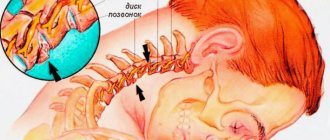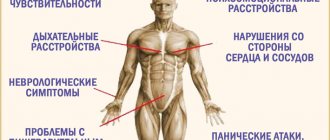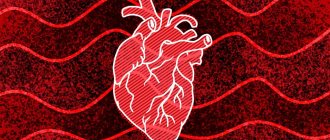Kinds
Asthenia can manifest itself in at least 3 forms:
- hypersthenic: this form is characterized by excessive incontinence and irritability, impatience in any area; such activity manifests itself randomly, without a clear goal, there are many actions, but all of them remain unfinished due to rapid fatigue;
- hyposthenic: form opposite to the previous one; this is asthenia in the classical sense - exhaustion, both physical and mental; motivation for activity is maximally reduced, there is no interest in the outside world at all, performance suffers significantly;
- form of irritable weakness: occupies an intermediate place among the above forms; here there is both excessive excitability and manifestations of weakness and exhaustion - moreover, excessive apathy and activity replace each other.
According to the etiological factor, asthenia is divided into organic and functional. Functional asthenia is observed in approximately 55% of cases and is a reversible temporary condition that develops as the body’s reaction to an acute illness, physical fatigue, or a stressful situation. Therefore, this type of asthenia is also called reactive.
The development of organic asthenia is associated with progressive organic pathology or somatic chronic diseases. Often this psychopathological syndrome is observed in patients suffering from diseases of the central nervous system:
- degenerative processes (senile chorea, Parkinson's disease, Alzheimer's disease);
- vascular disorders (ischemic and hemorrhagic stroke, chronic cerebral ischemia);
- demyelinating diseases (multiple sclerosis, multiple encephalomyelitis);
- severe traumatic brain injury;
- infectious organic diseases of the brain (tumor, abscess, encephalitis).
Classification of asthenia
Also, taking into account the cause of development, post-infectious, postpartum, post-traumatic and somatogenic asthenia are distinguished.
According to the clinical picture, asthenia is divided into two forms:
- Hypersthenic. It is characterized by severe irritability, which is why patients cannot tolerate bright light, noise, or any loud sounds.
- Hyposthenic. There is a decrease in susceptibility to any external stimuli, as a result of which the patient develops drowsiness, lethargy, and apathy.
The hypersthenic form is considered a milder variant of asthenia. As the patient's condition worsens, it may be replaced by a hyposthenic form.
According to the duration of the course, asthenia is divided into acute and chronic. Acute asthenia usually occurs after acute somatic diseases (gastritis, pyelonephritis, pneumonia, bronchitis), infectious diseases (dysentery, infectious mononucleosis, rubella, influenza, measles) or severe stress, i.e., it is essentially functional.
Chronic asthenia is characterized by a long course. It is most often organic in origin. A variant of chronic asthenia is chronic fatigue syndrome (burnout syndrome, manager's syndrome).
Neurasthenia is considered as a separate form of asthenia, the development of which is caused by a significant depletion of central nervous activity.
We use Eleutherococcus
The treatment regimen for nervous asthenia often includes taking a medicine prepared from Eleutherococcus. The roots are used to prepare the product. Pour 200 g of crushed raw materials into a liter of vodka. Cover the container with a lid and leave in a dark place for two weeks. The mixture needs to be shaken periodically. It is better to store the strained finished tincture in the refrigerator. It is recommended to take 30-40 drops twice a day. By the way, you can buy a ready-made tincture at the pharmacy.
It has been proven that Eleutherococcus root extract helps normalize metabolism, stimulates the activity of the central nervous system, increases visual acuity, and mobilizes the entire body. The tincture is used not only for asthenia - it is also prescribed to patients with hypochondria and depression.
ICD-10 code
- In the well-known classifier of the World Health Organization ICD-10, asthenia occupies a place in the subclass “malaise and fatigue” (code R53): asthenia NOS (without further specification), including a number of characteristic disorders - weakness, fatigue, general physical exhaustion, even lethargy. Asthenia is also included in the structure of subclass G93.3 (heading “Other brain disorders”) - “fatigue syndrome after a viral illness.”
- This disorder is mentioned in the subgroup of somatoform disorders (F45.3) - as neurocirculatory asthenia (better known as vegetative-vascular dystonia - a general dysfunction of internal organs due to inadequate functioning of the autonomic nervous system).
- In general, the pathology also concerns psychasthenia, which is in the subclass of other specified neurotic disorders (code F48.8).
Asthenoneurotic syndrome – F06.6. Neurasthenia – F48.0. Malaise and fatigue – R53.
Let's talk about asthenic syndrome
Unlike ordinary ailments, asthenic manifestations are a pathological process. The difference in these two concepts is as follows. Overwork and fatigue are short-term phenomena that go away after normal rest. Asthenic syndrome is fatigue that accompanies a person constantly, and even proper rest does not always lead to an improvement in the situation. This pathology can lead to depressive syndrome, and therefore requires professional treatment.
Risk factors
All risk factors can be divided into several groups: external and internal factors, personal characteristics of a person.
- External factors include: frequent stress, overwork, insufficient time for rest and poor living conditions. All this leads to the appearance of the syndrome even in completely healthy people. Psychologists believe that such a lifestyle can lead to disruption of the central nervous system, and, consequently, to a deterioration in health.
- Internal factors most often include diseases of internal organs or various infections, especially when a small amount of time is allocated for their therapy and rehabilitation. In this case
- the body cannot completely return to a normal lifestyle, which leads to asthenic disorder. In addition to infections and somatic diseases, asthenia can also be caused by bad habits, for example, smoking and regular abuse of alcoholic beverages.
- It has been proven that the development of asthenic disorder also occurs due to a person’s personal characteristics. For example, if a patient underestimates himself as a person, is prone to excessive dramatization, or suffers from increased impressionability, most likely, the appearance of asthenia in the future cannot be avoided.
Treatment of asthenia
General recommendations for asthenia boil down to selecting the optimal work and rest regime; refusal of contact with various harmful influences, including alcohol consumption; introduction of health-improving physical activity into the daily routine; following a diet that is fortified and corresponds to the underlying disease. The best option is a long rest and a change of scenery: vacation, sanatorium treatment, tourist trip, etc.
Patients with asthenia benefit from foods rich in tryptophan (bananas, turkey meat, cheese, wholemeal bread), vitamin B (liver, eggs) and other vitamins (rose hips, black currants, sea buckthorn, kiwi, strawberries, citrus fruits, apples, raw vegetable salads and fresh fruit juices). A calm work environment and psychological comfort at home are important for patients with asthenia.
Drug treatment of asthenia in general medical practice comes down to the prescription of adaptogens: ginseng, Rhodiola rosea, Chinese schisandra, Eleutherococcus, pantocrine. In the USA, the practice of treating asthenia with large doses of B vitamins has been adopted. However, this method of therapy is limited in the use of a high percentage of adverse allergic reactions. A number of authors believe that complex vitamin therapy is optimal, including not only B vitamins, but also C, PP, as well as microelements involved in their metabolism (zinc, magnesium, calcium). Often, nootropics and neuroprotectors are used in the treatment of asthenia (ginkgo biloba, piracetam, gamma-aminobutyric acid, cinnarizine piracetam, picamelon, hopantenic acid). However, their effectiveness in asthenia has not been definitively proven due to the lack of large studies in this area.
In many cases, asthenia requires symptomatic psychotropic treatment, which can only be selected by a specialist: a neurologist, psychiatrist or psychotherapist. Thus, on an individual basis, for asthenia, antidepressants are prescribed - serotonin and dopamine reuptake inhibitors, neuroleptics (antipsychotics), procholinergic drugs (salbutiamine).
The success of treating asthenia resulting from any disease largely depends on the effectiveness of the treatment of the latter. If the underlying disease can be cured, the symptoms of asthenia usually disappear or are significantly reduced. With long-term remission of a chronic disease, the manifestations of asthenia accompanying it are also minimized.
Asthenic disorder seriously worsens the patient’s quality of life and simple recommendations in the form of following a daily routine will not help here; an asthenic person is not able to cope with this on his own, so a visit to a specialist as early as possible will help identify the type of asthenia and what it is associated with. How to treat asthenic syndrome?
Tablets for asthenia
Drug treatment of asthenic syndrome is aimed at increasing the body's defenses and adaptation to stress factors; in severe cases, tranquilizers and antipsychotics are prescribed. The main medications for asthenia are adaptogenic drugs with nootropic and psychoenergetic properties:
- Betimil – restorative and reparative effect for 3-5 days in asthenic conditions. Accelerated rehabilitation and restoration of working capacity.
- Metaprot – increases the body’s resistance to adverse environmental influences (stress, hypoxia), increases performance.
- Tomerzol - increases glycogen reserves in the liver, which is the energy resource of the human body. Improves blood circulation, which is important for asthenia.
Vitamin preparations carefully selected by the therapist for asthenia help in addition to the main therapy:
- Vitamin E is necessary for metabolism and cell renewal of the central nervous system.
- B1 (thiamine) – deficiency affects the functioning of the entire nervous system. Not produced by the body, comes only with food and vitamin preparations.
- B6 (pyridoxine hydrochloride) – restores the body’s vital resources, increases nerve conduction.
- B 12 (cyanocobalamin) – is involved in the regulation of nervous processes.
- Magnesium – a deficiency of this microelement in cells causes exhaustion of the nervous system.
It is important to remember that treatment with traditional medicine does not replace a visit and consultation with a doctor. How to treat asthenia with a natural pharmacy? There are adaptogens of plant origin that help restore the body to proper sleep, vigor and joy of life:
- tinctures of eleutherococcus, Chinese lemongrass, ginseng;
- mumiyo;
- bee products (apilak);
- preparations based on antlers and deer blood.
In the conditions of modern life, with its global informatization and constant flow of various information, intense mental stress, physical fatigue and an increasing level of morbidity, it is increasingly difficult for a person to be in a state of balance.
Adding to the disharmony is an unbalanced diet, neglect of the daily routine, and an almost total replacement of spending time in the fresh air with leisure time in front of the TV or computer monitor.
The latter is further aggravated by the decline in active socialization - direct communication between people without the use of technical devices.
All these factors, independently or in combination, become a strong basis for the development of asthenia (asthenic syndrome).
For a general understanding of the questions: what it is, what causes it and who is at risk, we will help you understand this terminology.
The term “asthenia” is derived from the Greek word “sthenos”, which literally means strength, vital activity. The prefix "a-" means negation. As a result, asthenia is impotence, inactivity in life.
The medical definition of asthenic syndrome is a state of exhaustion of the body against the background of pre-diseases or existing or resolved pathologies, manifested by psychopathological disorders.
In the general understanding, these are emotional disorders in the form of decreased mood in the hyposthenic type or, on the contrary, manifested by nervousness (irritability) in hypersthenia.
Usually this condition occurs against the background of a current or past illness.
But it can also manifest itself as a result of severe emotional shock, and also, in the mildest degree, against the background of complete health - asthenia of overwork.
In information sources there are variations of the term: neuro-asthenic syndrome, neuropsychic weakness, asthenic conditions or reactions, chronic fatigue syndrome.
According to the International Classification of Diseases (10th revision) it is defined as neurasthenia (code F48.0) and refers to other neurotic disorders.
Without taking into account the signs of diseases against the background and due to which neuropsychic weakness occurs, a set of signs characterizing the state of emotional exhaustion has diagnostic significance. These are mainly disturbances in the processes of higher nervous activity. These include:
- severe weakness;
- extremely rapid fatigue (even with minor loads) and reduced performance;
- daytime drowsiness and sleep disturbance (prolonged falling asleep, rare or absent dreams, light shallow sleep);
- decreased interest in life, apathy, loss of desire for favorite activities;
- disturbances in memory processes (short-term), difficulties in learning new material, suppression of analytical abilities;
- nervousness, irritability, negativity in views and contradictions, increased criticism of others;
- decreased libido, sexual dysfunction;
- changes in blood pressure and pulse rate, unmotivated shortness of breath, pain in the lower back muscles, chilliness in the legs, disorders of the digestive and urinary system.
Concussion
The last section of signs is manifestations of autonomic disorders. What brings asthenic syndrome closer to vegetative-vascular and neurocirculatory dystonia.
Asthenia, to the mildest extent, can develop in an absolutely healthy person.
A sufficient reason for this may be a short period of intense intellectual stress (exams, quarterly reports, etc.) or physical overexertion for several days without proper rest.
A long flight with acclimatization or being on the road for several days is even possible as a starting point.
Etiologically significant factors are divided into 4 main groups.
- Emotional. In addition to the above reasons, a pronounced stress reaction is taken into account (breakup of a relationship, death of a loved one, disaster). In adolescents, there is a conflict between generations or among peers (non-acceptance by the group). For older people - a feeling of uselessness. Careerists are susceptible to emotional asthenia.
- Somatic. Chronic diseases of internal organs, accompanied by frequent exacerbations or in subclinical form, depending on the severity of their own symptoms, lead to a debilitating condition for the patient. In such a situation, they say about asthenic syndrome, that this is a patient “when he is tired of being treated and fighting.” Neurasthenia develops gradually, but with increasing manifestations.
- Cerebral. This group contains diseases of various natures: traumatic brain injuries; congenital malformations leading to disruption of the central nervous system; infections – meningitis, encephalitis; vascular disorders – atherosclerosis, stroke. In such situations, there is a direct impact on the emotional centers.
- General and specific infectious diseases. Here, any possible extracerebral inflammatory processes of a microbial nature are conventionally considered. Many viral and bacterial diseases occur with cerebral syndrome - directly or indirectly affecting brain functions. Not wanting to lose working hours or for other reasons, people with ARVI do not limit their activities, which quickly leads to severe exhaustion.
Lifestyle
Diagnostics
Typically, diagnosing asthenia does not cause any difficulties for specialists, since the clinical picture is quite pronounced. Symptoms of the disease can be hidden only if the true cause of the syndrome is not established. The doctor must pay attention to the patient’s emotional state, find out the characteristics of his sleep and attitude to everyday events. During the survey, it is necessary to use special tests. It is also necessary to evaluate a person’s reaction to various stimuli.
Asthenia, which develops as the first symptom of a disease or is a consequence of an acute illness, injury or stress, usually has pronounced manifestations, so its diagnosis is not difficult.
If asthenia develops during the height of the underlying disease, its symptoms may be subtle against its background. They can only be identified through a thorough analysis of the patient’s complaints. During the conversation with the patient, special attention is paid to questions about the quality of sleep, mood, and performance status. Some patients with asthenia tend to exaggerate their complaints, while others, on the contrary, do not give them due importance.
In some cases, asthenia must be differentiated from depressive neurosis, hypersomnia, and hypochondriacal neurosis.
A comprehensive examination is necessary to establish the cause of asthenia
If an infectious disease is suspected, PCR diagnostics or bacteriological examination of blood, urine, and feces are performed to identify the infectious pathogen.
Typically, diagnosing asthenic syndrome is not difficult for a qualified doctor. They assess the patient’s emotional state, his sleep patterns, lifestyle, and listen to complaints. A doctor who has been working with patients with asthenia for a long time notices characteristic lethargy at first glance.
If symptoms persist for several months, you should consult a doctor. Such a disorder becomes dangerous for a person’s mental and physical health. From the outside it may seem that the patient is too lazy to perform basic actions, when in fact he overcomes himself, still feeling unwell.
To find out the exact cause of fatigue syndrome, a number of examinations are prescribed:
- MRI of the brain;
- Ultrasound of internal organs;
- radiography;
- examinations by a gynecologist, neurologist, cardiologist, etc.;
- blood test for hormones and vitamins.
A set of tests and examinations is always prescribed on an individual basis, depending on chronic diseases and symptoms. Typically, some of the tests are related to existing chronic disorders. The other part is aimed at studying the lack of microelements and vitamins in the body.
Some diseases can cause chronic asthenia and need to be ruled out before a definitive diagnosis can be made.
Diseases such as hypothyroidism, diabetes, anemia and some mental disorders are some examples of diseases that need to be investigated in a patient when he has chronic asthenia.
People with fibromyalgia, for example, like those with chronic asthenia, may experience muscle pain, extreme fatigue and sleep disturbances. On the other hand, fatigue and muscle pain often appear early in various inherited muscle disorders, as well as in various metabolic, autoimmune and endocrine conditions.
The mechanism of development, or pathogenesis, of asthenia
Asthenia is the human body’s reaction to conditions that threaten to deplete its energy resources. With this disease, first of all, the activity of the reticular formation changes: a structure located in the area of the brain stem, responsible for motivation, perception, level of attention, ensuring sleep and wakefulness, autonomic regulation, muscle function and activity of the body as a whole.
Changes also occur in the functioning of the hypothalamic-pituitary-adrenal system, which plays a leading role in the implementation of stress.
Numerous studies have shown that immunological mechanisms also play a role in the development of asthenia: in individuals suffering from this pathology, certain immunological disorders have been identified. However, currently known viruses do not have a direct role in the development of this syndrome.
How is the cause of asthenia diagnosed?
There are many treatment options for asthenia. But the first thing necessary for successful treatment is to determine the underlying cause. First, your doctor will order a urine test and/or blood test to look for signs of infection and possible medical conditions that may be causing weakness. If you have pain, your doctor may prescribe:
- X-ray
- MRI scan
- Computed tomography
- Ultrasound.
If a heart attack or stroke is suspected, you will be referred for a brain scan and electrocardiogram.
The mechanism of development, or pathogenesis, of asthenia
In approximately 45% of patients with asthenia, the causes of its development are due to organic damage to internal organs and systems. The risk group includes people with diseases of the cardiovascular system:
- hypertension of various etiologies;
- coronary heart disease;
- myocardial infarction;
- carditis;
- arrhythmia.
Asthenic disorder can also be provoked by: deficiency of nutrients supplied to the central nervous system, excessive energy expenditure, and metabolic disorders.
Asthenic manifestations are diagnosed against the background of pathologies of the gastrointestinal tract:
- dyspeptic disorders;
- pancreaduodenitis;
- peptic ulcer;
- gastroenterocolitis.
The appearance of asthenia is promoted by diseases of the genitourinary system: cystitis, chronic kidney pathologies, glomerulonephritis, pyelonephritis.
Possible causes of asthenia include disturbances in the functioning of the endocrine system caused by hypo- and hyperthyroidism, diabetes mellitus, and diseases of the adrenal glands.
Organic causes also include:
- systemic pathologies;
- allergic reaction;
- oncological diseases;
- congenital diseases of the kidneys, heart, lungs;
- hepatitis of various types;
- tuberculosis;
- meningitis;
- encephalitis;
- ARVI;
- autoimmune diseases.
In addition, vegetative-vascular asthenia is distinguished, which occurs against the background of VSD.
In addition to organic reasons, asthenia is caused by stopping taking a number of medications (withdrawal syndrome), giving up alcohol or cigarettes, severe stress, prolonged and excessive physical activity.
People with low intelligence, living in distant settlements or with dementia are susceptible to asthenic disorder. In this case, the cause of the psychopathological condition lies in irreversible changes affecting the brain. Vascular diseases (atherosclerosis) also lead to such disorders.
Folk recipes for asthenic conditions
Traditional medicine can be called upon to help in the fight against asthenia; in its bins there are recipes to reduce the symptoms of the disease. You can use the following; they have already been tested in practice by more than one patient.
- Prepare a mixture of equal quantities of hawthorn, chamomile and St. John's wort flowers. Take 1 tsp. mixture and pour a glass of boiling water, leave for 15 minutes. Strain and drink in small sips before going to bed. The course must be continued for 2 months. This remedy increases vitality and returns interest in life.
- To invigorate a person, you need to mix an equal amount of lavender, linden, hop cones and St. John's wort flowers. Then 1 tsp. pour boiling water over it and you can drink it like regular tea (2-3 times a day).
- If you really have no strength at all, then this remedy will help. You need to take 1 tsp. hawthorn flowers, calendula, burdock, rosemary leaves and mix with a small amount of ground coffee. Pour 0.5 liters of hot water and leave for a couple of hours. You need to drink in the morning after meals and in the evening.
These simple recipes will help you cope with asthenia.
How will green tea infusion help?
Treatment of asthenia with folk remedies often includes taking a decoction of green tea. This is an absolutely safe, but extremely useful remedy that gently stimulates the nervous system, helps remove toxins and excess fluid from the body. Moreover, it is an affordable product that is sold in almost any store.
Pour 100 g of green tea leaves (without impurities) into 2 liters of water, leave for 30 minutes, then put on low heat. The product should be cooked for 60 minutes (it should be stirred periodically). Strain the mixture, and pour the remaining tea leaves again with a liter of water and cook for 40 minutes. We pour both decoctions into one container and keep them in a water bath for several minutes. The resulting product should be stored in the refrigerator. Take 2 tablespoons 3-4 times a day.
Folk remedies
1. Manchurian Aralia tincture is used as a remedy:
- has a tonic effect on the body;
- increasing motor functions;
- relieves drowsiness;
- affecting the stimulation of the heart muscles.
A tincture is prepared from the roots of the plant and alcohol (70%), in a ratio of 1:5. After 2 weeks of infusion in a warm and dark place, the product is filtered and taken 30 drops. 3 r/day 1 month.
2. Green tea is a stimulant and tonic, improves blood flow in the heart vessels due to expansion. Usually the drink (100 g of dry leaf and 2 liters of water) is infused for 10-20 minutes, then boiled for about 1 hour.
The strained liquid is pasteurized in a glass jar, this will help preserve the product for a long time. It is recommended to drink the decoction for adults - 3 times a day, 2 tbsp. l., for teenagers - 1 des. l., for children - 1 tsp. 2 rubles/day.
3. Coffee has a stimulating effect and activates the activity of the central nervous system. Drinking 2 cups of coffee relieves drowsiness and helps you collect your thoughts. Excessive intake of the drink ceases to be beneficial.
Coffee is contraindicated for people with diseases such as:
- heart failure;
- hypertension;
- angina pectoris;
- heart disease.
4. Tea of vigor. 1.5 tsp. a collection of St. John's wort, its flowers, lavender inflorescences, hop cones, pour 250 ml of boiling water, leave for 20 minutes. and drink it slowly instead of the usual morning tea.
5. A lavender bath at night allows you to get a good night's sleep and promote healthy sleep. Add 5-7 drops of lavender oil per bath of hot water. The water procedure is carried out no more than 2 times a week.
Effective medications for fatigue and depression are antidepressants: pipofezine (Azafen), sertraline (Deprefault, Serlift, Aleval, Seralin, Serenata), fluoxetine (Flunisan, Flooxetine, Floxetine Hexal, Prozac). All drugs are dispensed only with a doctor's prescription. Azafen has a sedative effect, reduces depression and vegetative, somatic and mental disorders associated with this condition, has a positive effect on asthenia that occurs as a result of complications of mental illness, reduces anxiety and feelings of internal tension, and normalizes sleep.
Zoloft, Sirlift, Deprefolt, Stimulon and other specific serotonin reuptake inhibitors, when used for a long time, lead to a decrease in the activity of adrenergic receptors in the brain and do not have a sedative or stimulating effect. Selective inhibitors (Fluval, Fluoxeting, Flunisan) have a stimulating effect, improve mood, reduce feelings of fear, anxiety and tension, reduce irritability, sleep disturbances and drowsiness, and improve performance.
To relieve fatigue, a medicine with a stimulating effect can be prescribed quite strong. In this situation, much depends on the severity of the symptoms of the pathology and the presence of concomitant diseases (especially depression and similar neurotic disorders). Tranquilizers suppress feelings of fear and anxiety, emotional tension, restlessness, and reduce irritability both in relatively healthy people and in various disorders (neurotic, neurosis-like).
Since such drugs reduce excitability, so-called “daytime” tranquilizers are used in the treatment of chronic fatigue syndrome. These are very effective anti-fatigue medications, but they require caution when used. This is confirmed not only by doctors, patients also talk about the need to strictly follow the recommendations.
Rubbing and water procedures
You already know that folk remedies can be used to treat asthenia. But with such a disease, an integrated approach is necessary. Experts recommend daily rubbing. This should be done using a glove or a hard towel. You need to rub the skin in a circular motion starting from the cheeks and neck, gradually moving towards the lower extremities.
In addition, a daily cold shower will be effective (of course, the water should not be icy). These are simple procedures that nevertheless tone the body, help remove excess fluid and significantly improve blood supply to tissues.
Drugs that most often cause asthenic disorders
Sometimes, for a variety of reasons, we are forced to take medications that affect the nervous and endocrine systems. Taking them can lead to asthenic and anxiety-neurotic conditions. A big risk in this regard is taking medications from such groups as:
- β-blockers;
- sleeping pills;
- antihypertensive drugs;
- sedatives;
- tranquilizers;
- antiallergic medications;
- glucocorticosteroids;
- hormonal contraceptives.
Since asthenia often develops against the background of other diseases, it is very important to correctly determine the cause of such manifestations. This is especially necessary when a person finds himself in a difficult life situation. It is very important to get advice from a competent specialist in the following cases:
- The onset of menopause in women.
- Pregnancy.
- Long-term loss of appetite.
- Sharp weight loss.
- Severe mood swings.
- The appearance of asthenic signs after injury.
- If asthenia does not go away for a long time.
If a person is given appropriate help in a timely manner, he will get back into his usual healthy groove much faster.
Hypersthenic:
- With this form of asthenia, women experience increased anxiety.
- Constant anxiety.
- Marked impatience, nervousness.
- These symptoms are expressed even in neutral life situations.
Hyposthenic:
- Here it's the other way around:
- I don’t care about everything, everything is indifferent.
- Symptoms of depression appear.
- Tearfulness, absent-mindedness.
- Performance is clearly reduced.
- Muscle weakness is pronounced.
- Sleep is disturbed.
- Memory suffers, attention weakens.
- No self-confidence.
- Focusing on solving any problem is an impossible task.
- Appetite is reduced.
- Sexual disorders are pronounced.
- There is shortness of breath.
- It’s like a middle ground between the two forms of asthenia described above in women.
- The woman is excited, but at the same time weak and exhausted.
- There are sharp transitions from obvious activity to complete apathy.
Prevention of asthenic syndrome
Prevention of asthenia is based on preventing the occurrence of the causes that cause it. It includes measures aimed at increasing the body’s resistance to the effects of negative environmental factors:
- rational and proper nutrition;
- rejection of bad habits;
- regular exposure to fresh air;
- moderate exercise;
- compliance with the work and rest regime.
In addition, it is necessary to promptly identify and treat diseases that can lead to the development of asthenia.
You should not neglect going to the doctor, since most often asthenia appears due to some chronic disease, which only a specialist can identify.
What to eat with asthenia?
Asthenic personality disorder needs correction on all fronts. Food is a building material for the body; how a person eats determines his energy state. For asthenia, this should be the most healthy diet, containing vitamins B, E, zinc, magnesium, phosphorus, and tryptophan protein. An approximate list of products for asthenic disorder:
- honey;
- red fish;
- eggs;
- whole wheat bread;
- dairy products;
- chicken, turkey meat;
- fruits and berries.











